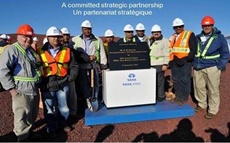Tata Steel likely to invest in Canada iron ore project
22 Apr 2014
Tata Steel is set to decide on an investment in New Millennium Iron Corp (NML's) iron ore mining and pellet project in Canada, as a feasibility study has established the viability of the project.
 Tata Steel, one of the largest steel producers in the world, is a strategic partner and the biggest single stakeholder in the Toronto Stock Exchange-listed New Millennium Iron Corp (NML), which is undertaking the project.
Tata Steel, one of the largest steel producers in the world, is a strategic partner and the biggest single stakeholder in the Toronto Stock Exchange-listed New Millennium Iron Corp (NML), which is undertaking the project.
Tata Steel owns approximately 26.3 per cent of New Millennium and is its largest shareholder and strategic partner.
The size of the proposed investment is yet to be decided.
New Millennium Iron Corporation controls the emerging Millennium Iron Range, located in the Province of Newfoundland and Labrador and in the Province of Quebec, which holds one of the world's largest undeveloped magnetic iron ore deposits.
In the same area, New Millennium Iron Corp and Tata Steel Limited have developed a direct shipping ore project to the production stage, from which trial shipments have begun.
Tata Steel exercised its exclusive option to participate in the DSO project and has a commitment to take the resulting production.
The DSO project is owned and operated by Tata Steel Minerals Canada Limited, which in turn is 80-per cent owned by Tata Steel and 20 per cent owned by NML.
The DSO project contains 98.9 million tonnes of measured and indicated mineral resources at an average grade of 59.3 per cent Fe, 6.7 million tonnes of inferred resources at an average grade of 56.7 per cent Fe and about 20.0 - 25.0 million tonnes of historical resources that are not currently in compliance with NI 43-101, New Millennium iron Corporation said in a statement.
Its LabMag mining contains 3.9 billion tonnes of proven and probable reserves at a grade of 29.7 per cent Fe plus 376 million tonnes of measured and indicated resources at an average grade of 29.6 per cent Fe and 891.0 million tonnes of Inferred resources at an average grade of 29.3 per cent Fe.
New Millennium's other mining operation KéMag contains 2.4 billion tonnes of proven and probable reserves at an average grade of 30.6 per cent Fe and 1.0 billion tonnes of inferred resources at an average grade of 31.7 per cent Fe.
Tata Steel also exercised its exclusive right to negotiate and settle a proposed transaction in respect of development of either or both the LabMag and the KéMag deposits.
The Millennium Iron Range now hosts other taconite deposits, including the Lac Ritchie property located at the north end of the range. The initial 2011 drilling of 40 holes in this property revealed indicated resources of 3.330 billion tonnes at an average grade of 30.3 per cent Fe, and inferred resources of 1.437 billion tonnes at an average grade of 30.9 per cent Fe.
The initial 2012 drilling at two other taconite deposits located south of the LabMag deposit in the Millennium Iron Range revealed indicated resources of 3.580 billion tonnes at an average grade of 31.22 per cent, and inferred resources of 795 million tonnes at an average grade of 30.56 per cent.
''The project financials have been evaluated with capital expenses, excluding certain infrastructure-related capital expenses in the mine, port and ferroduct (of over 600 km to carry the ore concentrate slurry to the pellet unit),'' NML said, adding that these would be owned by third parties.
''We are very pleased with the results of this joint study….We believe the results present a compelling case for a profitable, successful, long-term iron ore operation,'' Robert Patzelt, president and CEO, NML, said.
He said the favourable geological and mining characteristics of the two deposits - Labmag and KéMag in eastern Canada's sub-Arctic region - were ''manifested in the study's operating cost estimates''.
The study has suggested that the project has the potential to become one of the lowest-cost pellet producers of the world. It said the project would produce premium products whose estimated supply and demand will balance out over the next decade.
The project could produce 17 million tonnes a year two types of pellets and 6 million tonnes a year of pellet intermediates for export. NML had decided to submit ''a single environmental impact statement covering all the components of the project''.
Production of 22 million metric tonnes per annum of concentrate would suffice to produce 17.0 MTPA of pellets and 6.0 MTPA of pellet feed. (Actual total is estimated to be 23 MTPA due to weight gain during the pelletising process).
Pellet production consists of 12 MTPA of low silica (2.5 per cent SiO2) blast furnace grade fluxed pellets and 5 MTPA of direct reduction grade pellets with 1.8 per cent SiO2.
6 MTPY of pellet feed containing > 69.0 per cent Fe and 2.2 per cent SiO2.
Product prices are based on a long term price forecast of $103 for 62 per cent Fe fines CFR North Chinese ports.
This forecast was developed by World Steel Dynamics, Englewood Cliffs, New Jersey, USA, marketing consultant for the study.
After adjustment for ocean freight and quality factors, the assumed product prices loaded into ship at the Port are as follows: pellet feed $90 per tonne, BF grade pellets $116.61/t and DR grade pellets $126.86/t.
Exchange rates used for the cost estimates and revenues in the financial evaluation are $0.90 and € 0.71 per CAD$1.00.
Project economics presented are based on a 25-year mine plan for LabMag and 22 years for KéMag.
Mine life will increase to 42 years and 25 years for LabMag and KéMag, respectively, if additional reserves are included and if mined concurrently or in succession, to a combined life of 61 years, the statement said.





















